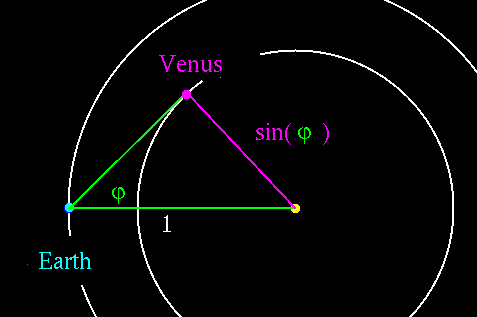Distance to the Sun
The mean Earth-Sun distance is very important in astronomy. It is called
1 Astronomical Unit or 1 AU.
It is rather easy to determine distances within the Solar System if you
measure them in AU's.

- The planets move around the Sun in orbits.
- The orbits are really ellipses, but for our purposes we can
consider them to be circles.
- Call the radius of the orbit a.
- This is the distance from the planet to the Sun.
- Let us measure a in AU.
- Thus for the Earth, a = 1.
- By observing the position of a planet in the sky over a period
of months, we can determine the radius a of its orbit.
- Here is an example.

- This involves trigonometry, which is beyond the knowledge
base assumed for this course.
- But you can see that you could measure
the distance to Venus this way by simpling measuring the angle
shown in the sky, making a scale drawing on a piece of paper, and
measuring the distance between the Sun and Venus on
your paper.
- Knowing the distance to Venus in AU, we could measure how
big 1 AU is in km if we could measure the distance to Venus in km.
- The most accurate way to do that is to bounce a radar signal
off of Venus.
- Radar is microwave electromagnetic radiation.
- Therefore it travels at the speed of light, c = 3 x 108m/s.
- We can measure the time t it takes the signal to get to
Venus and back.
- The distance it went (twice the distance from Earth to Venus) is
c t.
Methods like this give 1 AU = 150 x 106 km.
Later, we will want to know distances to stars. Getting the distance from
the Earth to the Sun right is the first step.
Davison E. Soper, Institute of Theoretical Science,
University of Oregon, Eugene OR 97403 USA
soper@bovine.uoregon.edu


